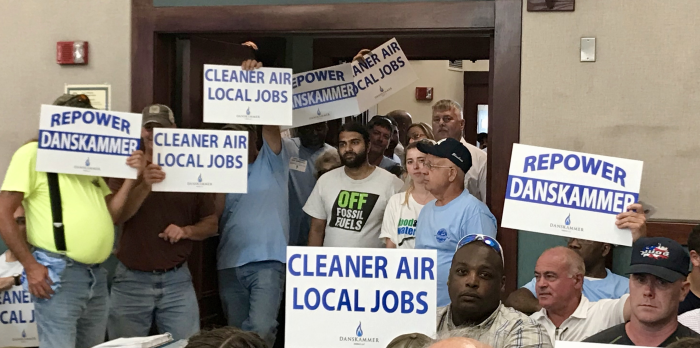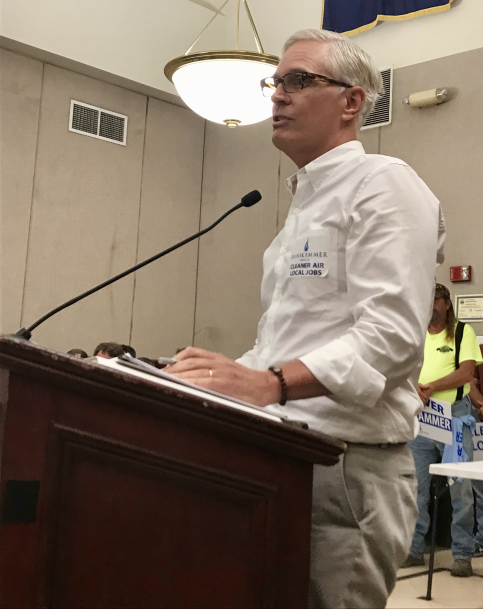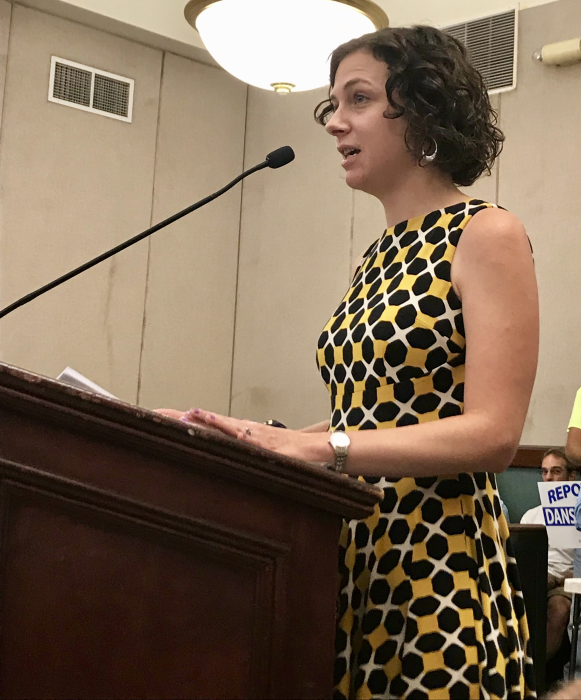Beacon council hears testimony on Danskammer
By Jeff Simms
Well over 100 people packed into Beacon City Hall on Monday (July 29) for a City Council workshop that at times resembled a court proceeding, with litigants taking turns for nearly 90 minutes arguing for and against the proposed expansion of the Danskammer power plant in Newburgh.
Once the testimony was complete, however, council members left little doubt that they plan to adopt a resolution on Aug. 5 opposing the company’s $450 million proposal to rebuild its nearly 70-year-old facility.

If the council passes the resolution, Beacon will become the third municipality in the Highlands — following Cold Spring and Philipstown — to speak out against the project.
Danskammer operates a seldom-used, gas-powered plant that its owners admit is long outdated. Located in the Town of Newburgh, it is 8 miles from Beacon but only a few thousand feet from the Hudson River. It is in the “pre-application” phase of Article 10 of the Public Service Law, the state’s five-step procedure for reviewing power-plant building proposals. It involves public outreach and submitting detailed information to the seven-member Board on Electric Generation Siting and the Environment, which is part of the Department of Public Service.
A formal application will follow, and if deemed complete, board officials will schedule a public hearing.
Although the hearing would be the highest-profile opportunity for the public to weigh in, the state board accepts comments throughout the Article 10 process. On Wednesday (July 31), a representative said more than 3,600 comments have been received so far.

On Monday, with more than 50 union workers spilling from the audience into the City Hall lobby, Danskammer officials asked the council to wait until the proposal had been reviewed by the state before taking a position.
“Let us finish our work,” said Bill Reid, Danskammer’s CEO. “The state has assigned us a 1,000-page term paper. Let us get our grade before you decide it’s a bad idea.”
The new plant, Reid said, would use fracked gas to run more regularly and more efficiently once Indian Point closes in 2021. It would be fast-starting and air-cooled, rather than water-cooled. Its construction would be privately funded, he said.
However, the plant would fall short of New York’s Climate Leadership and Community Protection Act (CLCPA), which calls for net zero carbon emissions from the generation of electricity by 2040. Gov. Andrew Cuomo signed the act into law on July 18 (see Page 18).
At the Monday meeting, Todd Diorio, the president of the Hudson Valley Building and Construction Trades Council, said the goals of the CLCPA “are not reachable” and argued that an expanded Danskammer plant would fill in gaps that renewable energy sources may not meet.

“If we are to move to renewable power, we want to do it in the best way possible,” said Reid, the Danskammer CEO. “If we want to support a grid that is very violent in its movement, we have to have technology that can turn on in minutes and can ramp up very, very quickly. All of the plants that we have in the region now cannot do that.”
Representatives from Scenic Hudson and Food and Water Watch asked the council to oppose the plant, which they argued would increase pollution, create public health hazards and contribute to climate change.
While Danskammer says its new plant will be an economic boon and an environmental improvement, Hayley Carlock of Scenic Hudson countered that its dependence on gas, a non-renewable fossil fuel, would lock the region into relying on a plant that she said would be outdated before it’s even built.
“The Hudson Valley should be a model for sustainable and clean energy, not for continuing to use fossil fuels,” she told the council.
Additionally, methane, the primary component of natural gas, traps much more heat in the earth’s atmosphere than carbon dioxide, said Andrew Pezzullo, an organizer at Food and Water Watch. Fracked gas, he said, “has a more accelerative effect on climate change than coal or oil. The science is fundamentally clear at this point.”
Those arguments seemed to resonate with the Beacon council, which needed only a few minutes to set its course for Monday.
“We have an obligation to use our voices to make a statement,” said Council Member Amber Grant. “I do not want to see the Hudson Valley become the center for natural gas and fossil fuels. I’m distinctly opposed to this.”
With the other members in agreement (Ward 2 representative John Rembert was not at the meeting), the council is primed to approve a resolution urging Cuomo to reject the Danskammer proposal and, instead, focus state resources on providing “living wage jobs for the construction and operation of clean-power generation, brownfield cleanup, or other appropriate economic development projects” in the region.
The draft also indicates that the council will “fully and objectively” consider any new information discovered during the state’s review.

The same people who oppose Danskammer in Newburgh and other electric power plants are the first to complain when there is a blackout or brownout during high demand for air conditioning or heat, or when their Central Hudson bill is too high.
Where do you think electrical power will come from that is dependable and somewhat lower-cost? It won’t be solar or wind. There is not enough land to build solar farms to meet the demand and wind has its issues, as well. I keep hearing that these gas and oil plants pollute the air (God forbid we build nuclear) and yet in the winter I see many homes burning “wet” wood, polluting Beacon neighborhoods with stinky smoke, and nobody seems to care.
The Arctic is on fire. Greenland lost 12.5 billion tons of ice in a day. I could go on and list every single disaster made worse by climate change, but if you don’t believe it’s happening now, there is nothing I can do to convince you.
If you’re still with me, we cannot afford to put one more drop of carbon into our atmosphere. We cannot build new fossil-fuel infrastructure. It’s completely incompatible with the new state Climate Leader and Community Protection Act (CLCPA) that mandates 70 percent of electric power demand be met by renewables.
It is highly likely all natural-gas-fired plants will need to close by 2040 to meet the CLCPA’s ambitious (and highly neces-sary) goals. How will we get there, especially with Indian Point closing? We need to increase our energy-storage capacity, which helps provide power when the sun doesn’t shine and the wind doesn’t blow. We can get more hydro from Canada if we build the transmission lines.
I’m not an energy expert, but why can’t we build solar on every rooftop of every school, big box store, mall and factory? Do we need good-paying jobs? Absolutely. There will be no shortage of jobs in trying to meet the CLCPA goals. We need HVAC installers, electricians, solar installers, people to conduct energy audits on homes and commercial buildings and then weatherize them so they aren’t wasting energy. That is what we need. Another gas-powered plant? Absolutely not.
*Michael Hudson* generally postulates that the oil and gas industry runs the county’s foreign policy in concert with the banking industry’s petrodollar strategy. The supreme imperative of their narrow business interests compel this (and, I think, related industries) to deny climate change and to continue to spew all kinds of pollution with impunity, and to distract, then deny, and finally if necessary defend their abominable actions via manipulations in the court of public opinion, which they are able to do so because of the immense financial and media power they wield.
*Dmitry Orlov* has talked about the concept of an “iron triangle” into which much of the middle class is forced – housing at one corner, shopping at another, and jobs at the third – and whereby almost everyone is forced to operate an automobile, burn gasoline (and waste hours of time in traffic) even if they don’t want to and prefer to live differently. This triangle may appear to have been intentionally planned and created. In part via suburbanization and zoning, it was, but not entirely so, as people generally if they can avoid it prefer not to live inside shopping districts and amusement parks, or near factories or office parks, or near the centers of cities or nearby to busy transportation hubs.
*Guy McPherson* speculates there are only twelve years are left and that it’s already too late to change the course. I am not sure he is correct but if he is there is no point in rebuilding any-above ground structures intended for year-round human habitation – rather it will be tunnels and caves, at least for the hottest and coldest days of the year. Those would of course have to be above the rising water tables. The largest cities will literally become – are becoming – ovens, more commonly but less alarmingly described as “urban heat islands”. If people continue to live in them in numbers at some point it will simply not be possible to meet the rising demand for electricity for air conditioning.
Many have spoken of the need to reduce carbon emissions and if possible take carbon out of the atmosphere. Necessary and imperative. Another effort will likely to be to find ways to increase the emissivity of the planet such that it can better convect, conduct and radiate the heat, and to cool down faster than otherwise, even if and as the carbon cannot be taken out quickly enough.
They have polluting beasts such as Danskammer in western Pennsylvania, where my family lives. My eyes burn and my sinuses inflame every time I visit. There are lots of stories in the press about the adverse effects on people’s health, and I swear the sky even has a slightly yellowish tint. This is unacceptable and must be stopped.
A 635-megawatt plant in Rensselaer filed for bankruptcy in May, and a 1,000-megawatt plant in Athens filed in June. Both plants burn natural gas.
In December 2017, the organization that oversees the electric grid, the New York Independent System Operator, said the state only needed 600 additional megawatts of generating capacity by 2027, even with the closing of the Indian Point nuclear plant, and without any new power plants going online.
Yet the Hudson Valley is looking at three new natural-gas-burning plants: The 650-megawatt CPV plant has started in Middletown, the Cricket Valley Energy Center in Dutchess County is under construction, and investors want to upgrade the Danskammer plant in Newburgh.
At the same time, there is an energy bottleneck that doesn’t allow surplus upstate electricity to move downstate, and wholesale electric rates were conveniently increased to make it profitable to build plants in the lower Hudson Valley.
Plans are underway to upgrade transmission lines to move electricity downstate from already-built generating facilities. The project is to be completed by 2023.
Just guessing: there’s a club comprised of investors, lobbyists, politicians, political donors and regulatory agencies that decides who makes money in the electricity business, who doesn’t make money, and who gets poisoned by fossil-fuel plant emissions.
I’m not a member of the club. Are you?